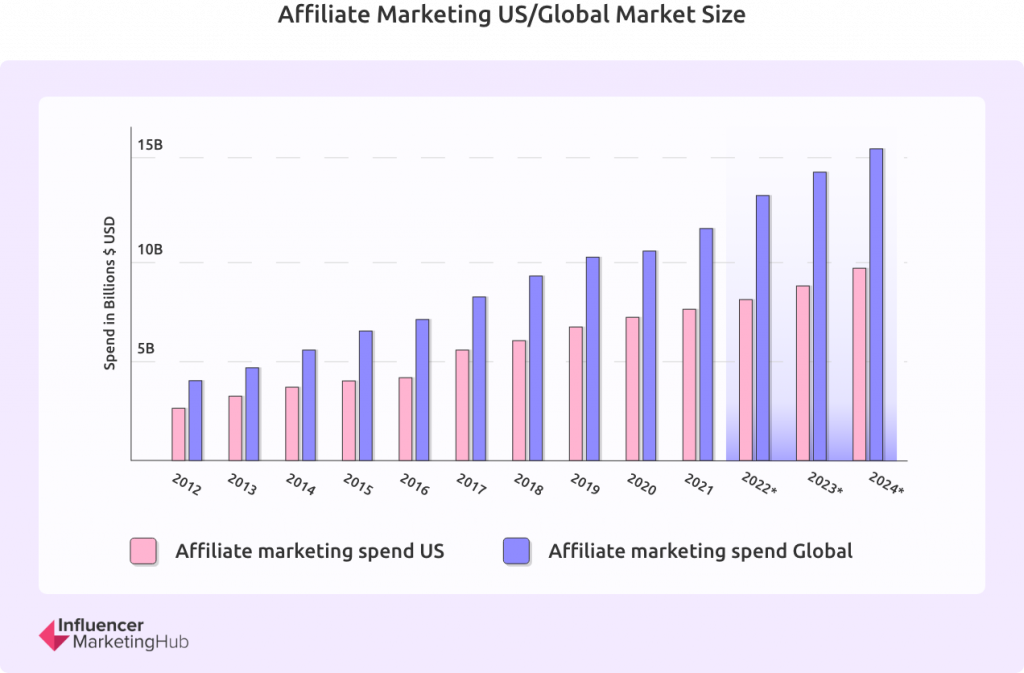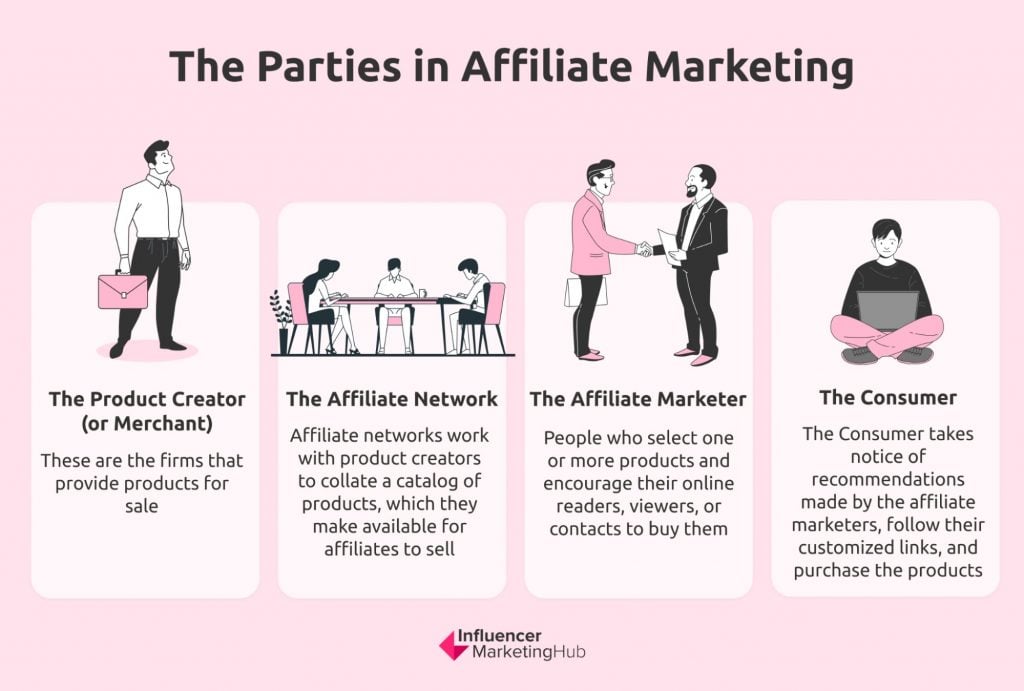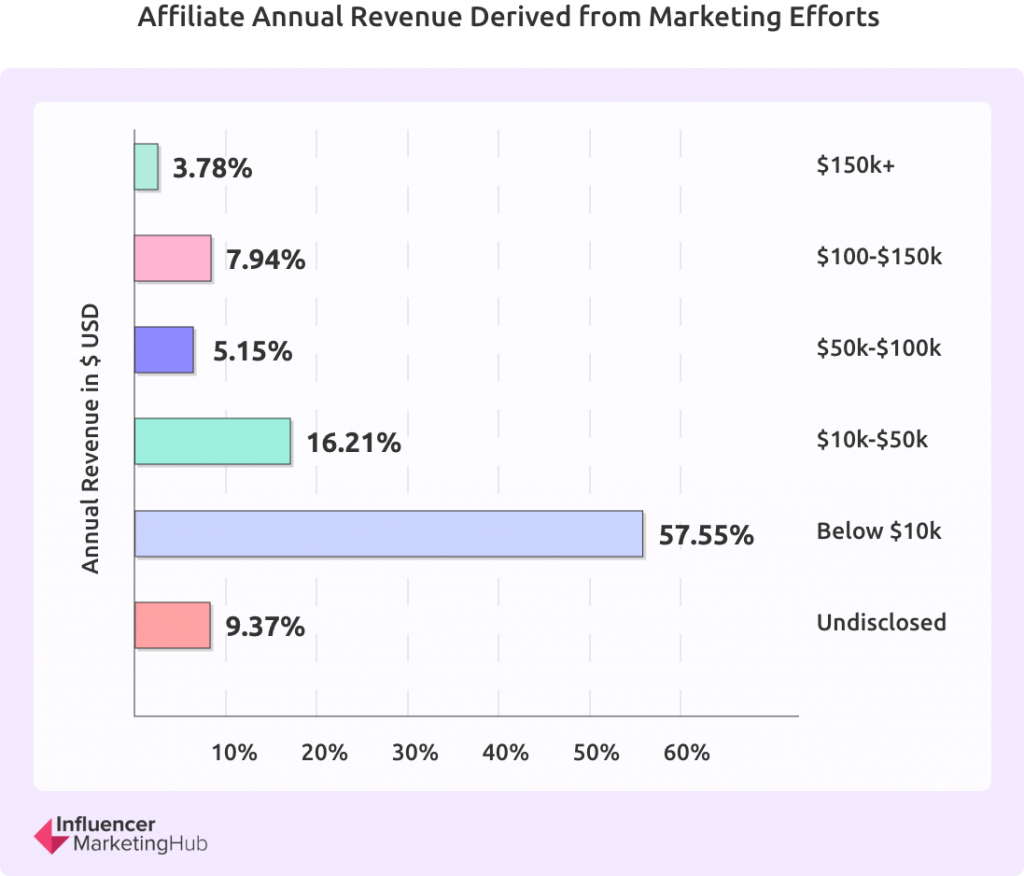Creating a business from scratch can often seem daunting. There seem to be a never-ending series of tasks you need to do, risks you must take, and you might wonder where you will get the money to fund everything. Being your own boss can be challenging work without the certainty you have when you earn a wage from an employer. And there is one question you need to ask ahead of anything else – what am I going to sell to earn my income? You could sell your services. You could make and sell your own goods. Or perhaps you could merely retail somebody else’s products. If you choose to sell goods, you will need to decide what to sell and find a way to source your stock. So many decisions you need to make, so much risk you need to take, so much work you have to undertake.
Use the FREE Affiliate Marketing Income Estimator below:
Affiliate marketing is a relatively simple way to become self-employed without the need for vast sums of money and other resources upfront. And after some initial work, you can earn passive monthly income with affiliate marketing, making it potentially lucrative too.

As we saw in our Affiliate Marketing Benchmark Report, the affiliate marketing industry is expected to grow to approximately $13 billion in 2022 and $15.7 billion by 2024. There are now 10,000 firms offering or specializing in affiliate marketing services. In addition, interest in affiliate marketing grew more than 300% between 2017 and 2021.
How to Make Passive Monthly Income with Affiliate Marketing:
What is Affiliate Marketing Income?
As its name suggests, affiliate marketing income is the money you earn through affiliate marketing. With affiliate marketing, sellers and creators work with affiliates (people willing to sell and promote their products) through various online media, like blogs, websites, YouTube videos, podcasts, etc. People interested in becoming affiliates sign up, hoping they can make some money by promoting the product to consumers, some of whom will ultimately decide to purchase it.
In many ways, affiliate marketing income is similar to the money you would earn as a salesperson. However, you are still your own boss with affiliate marketing and don’t work for the merchant company.
The key to success with affiliate marketing is having an online « home » where you can recommend products, whether a blog, specialist website, YouTube channel, podcast, or a sizable social media audience. If you don’t already have a reasonable number of followers, you should first spend your time establishing yourself online before you attempt to sell affiliate products.
How is Affiliate Marketing Income Passive Income?
In some ways, referring to affiliate income as earning « passive income » is a misnomer. You can’t just sit back and wait for the money to roll in. You have to build your audience and promote your affiliate products actively. You will have to work on your blog, website, YouTube channel, or other promotional platforms.
However, once you’ve set up your main promotional channel, you shouldn’t have to do too much work other than creating regular content and promoting that. Unlike other types of selling, you don’t have to worry about making or sourcing stock and ensuring that you have the proper stock levels. Over time, you may even be able to rely on evergreen content, i.e., past content that is so good that people continue to come back to it over and over again, and you can repromote it without having to create totally new material.

How the Affiliate Model Works
As we saw above, there are three parties to affiliate marketing transactions:
- The seller/product creator (depending on who operates the affiliate program – a manufacturer, a wholesaler, or a retailer like Amazon Associates.) We’ll call them the merchant in this article.
- The affiliate (the person who signs up to promote the product)
- The customer (the end-user who ultimately buys the product)
Sometimes, a fourth party, an affiliate network, acts as an intermediary between multiple merchants and affiliates.
Typically, a merchant or affiliate network assigns a unique piece of code (an affiliate link) to each affiliate. They can use this to track which affiliates direct traffic to their sales sites to attribute sales. For example, an affiliate will use their personal affiliate code in their marketing. An interested potential customer will click on the affiliate’s link, taking them to the merchant’s site. If, as a result, they buy the product (or often anything else) on their visit, the affiliate receives credit for the sale.
Affiliates typically earn income in one of three ways:
- Pay per click (PPC) – every time an affiliate directs traffic to the merchant’s site, they receive an agreed payment
- Pay per lead (PPL) – merchants pay affiliates based on the leads they generate
- Pay per sale (PPS) – merchants receive payment based on the number of sales the merchant makes that they can allocate to the affiliate’s link. This is effectively a commission and is the most common way affiliates make affiliate marketing income.
One Time Commission Model vs. Recurring Commission Model
-
One-Time Commission Model
This is the core affiliate marketing income model. Here you sign up with an affiliate merchant who agrees to pay you a fixed percentage every time somebody buys a product due to your promotional activities. The more sales you make, the higher your total affiliate marketing income.
These are one-time commissions because you will receive a single payment at an agreed rate every time somebody follows your affiliate link and makes a purchase.
-
Recurring Commission Model
The recurring income model really does help you earn passive monthly income with affiliate marketing. Here, you typically encourage a prospect to buy a subscription. Once they do, the merchant will make an affiliate payment to you as usual, but they also pay you every month that the customer still holds a subscription. Sure, you had to do all the hard work initially promoting the course (or other subscription-based affiliate product). Still, once someone has decided to pay for a subscription, you don’t have to do anything more, apart from checking your bank statement once a month.
Typical Levels of Affiliate Income
In some ways, asking for a typical level of affiliate marketing income is similar to asking how long a piece of string is. The answer will vary greatly from affiliate to affiliate.
We discovered statistics relating to this when we wrote our Affiliate Marketing Benchmark Report. We found that 3.78% of surveyed affiliates made more than $150,000 annual affiliate income, 7.94% $100,000 -$150,000, 5.15% $50,000 – $100,000, 16.21% $10,000 – $50,000, and 57.55% below $10,000. In other words, more than half of affiliates made less than $10,000, but nearly 12% made more than $100,000 affiliate marketing income.

This makes sense. The best affiliates have a large audience of potential followers to whom they can market. But even affiliate marketing superstars like Pat Flynn, who has earned over $3 million in affiliate revenue, had to start somewhere. Suppose you have the patience to build an audience. In that case, you are likely to rise from somebody earning a single-figure affiliate marketing income to someone earning six or even seven figures.
Affiliate payment rates depend very much on the mark-up of the products. If you sell products in a cut-throat industry, like computer hardware, you will receive much smaller commissions than in more niche industries, such as « self-help » products.
Also, you will typically receive more commission overall from expensive products than cheaper ones. However, you will probably find the costlier products harder to promote, leading to fewer sales, with potential buyers wanting to do more research when risking more significant sums of money.
Our Affiliate Income Calculator Can Estimate Your Potential Affiliate Marketing Income
Our Affiliate Marketing Calculator can give you an estimation of the amount of daily, weekly, and monthly income you can make from your affiliate marketing on your blog or website. You might need to go into your Google Analytics (or other specialist analytics platform) to get the most accurate information to enter into this tool.
Enter your average visitors to your site per day or month, along with the average page views per customer (i.e., the number of pages a typical visitor to your site sees on a visit). Then enter your clickthrough rate (CTR) for your Google Ads, your usual conversion rate, and the commission fee your affiliate merchant pays you for people you refer who make a purchase.
Our Affiliate Marketing Calculator will then calculate your CPM pageviews, as well as your daily, monthly, and yearly income from promoting your affiliate products.
Ways to Increase Your Affiliate Marketing Income
No matter what payment system applies, the primary way to increase your affiliate marketing income is to increase the number of relevant people you send to the merchant’s site. This is one of the reasons why influencers make such good affiliates. They already have a large following, so there is a greater chance of people clicking on the affiliate link and going through to the merchant’s site.
Strategies to Promote Your Affiliate Products
1. Choose Suitable Products to Promote
While you will find thousands of potential affiliate products, not all will be worth your while. Some sites offer meager affiliate commission rates, meaning that you will have to refer a large number of potential customers to make good money. These include popular affiliate programs like Amazon Associates, which reduced the commission rates on many product categories in 2020. For example, they cut the affiliate rate for purchases of furniture and home improvement products from 8% to 3%.
You might consider joining an affiliate network like CJ Affiliate or ShareASale. These collate products from various merchants, creating a catalog from which affiliates can choose suitable products. However, just because you have multiple choices at an affiliate network doesn’t mean that you should sell too wide a collection of products. It is much better for people to recognize you as an expert on just a few.
2. Operate a Blog
The key to being a successful affiliate is to have a sizable audience of people who are likely to take an interest in your affiliate products. One way you can achieve this is to set up a blog where you write quality posts that would interest such people. Alternatively, if you already have a successful blog (that attracts the right target audience), you can promote your affiliate products there.
If you operate a blog, you have to create regularly-updated content. This is what Google likes to see, and if your posts are of sufficient quality and follow the principles of good SEO, you should gradually build up your following and authority over time.
3. Ensure Your Content Provides Relevant and Useful Information
Whether you have a blog, YouTube channel, or simply rely on a sizable social media following, you need to ensure that you provide relevant and valuable information about the products you promote. You should primarily provide information to push people further down the purchasing funnel rather than trying any hard-sell techniques. You need to build trust and authority with your audience, not sound like a stereotypical used car salesperson or a peddler of snake oil.
4. Try to Ensure There is Some Synergy Between Your Affiliate Products
Some people think that the easiest way to make passive income with affiliate marketing is to promote as many products as possible. So, they sign up to every affiliate network alongside many other affiliate marketing products and try to promote everything. Often, they will even promote competing affiliate products.
The problem is that this is one of the easiest ways to lose an audience. You come across as being merely an advertiser, not caring about the products you promote. As a result, you don’t have the chance to provide sufficiently helpful information about your affiliate products, and potential buyers will instead look elsewhere.
The one situation where you might get away with promoting competing products is if you establish yourself as an expert in a clear niche. In that situation, you can link through to the sites of the best affiliate products in your product category.
It would be best to try to attract a particular audience, so you need to restrict yourself to products that would interest that group of people. Likewise, there is little point in creating quality content for the « wrong » types of products that won’t interest your audience.
5. Be Patient
Like most online marketing, the key to successful affiliate marketing is being patient. You are unlikely to make bucket loads of money overnight. If you don’t have a readymade audience, it may take you years before you make a sizable income. However, if you’re prepared to create helpful content and promote your affiliate products, you should gradually become profitable and feel that your time has been worth it.


